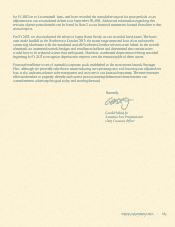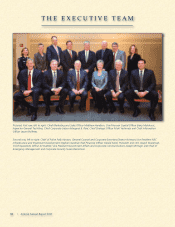Amtrak 2013 Annual Report Download - page 20
Download and view the complete annual report
Please find page 20 of the 2013 Amtrak annual report below. You can navigate through the pages in the report by either clicking on the pages listed below, or by using the keyword search tool below to find specific information within the annual report.
Amtrak Annual Report 2013 | 21
•Springfield Line: A 60.5-mile track segment from New Haven, Connecticut, to Springfield,
Massachusetts;
• Keystone Corridor: The 104 miles of up to 110 mph (177 kph) track in Pennsylvania between
Philadelphia and Harrisburg; and
• Michigan: A 96-mile segment of 110 mph (177 kph) track in Michigan and Indiana uses the
first high-speed positive train control system in revenue service outside the NEC.
Amtrak is the only railroad in North America to maintain right-of-way for service at speeds in
excess of 100 mph (160 kph) and our engineering forces maintain more than 350 route-miles of
track for 100+ mph (160 + kph) service.
We own 67 station structures, 48 platforms, and 38 parking lots. We have 23 tunnels consisting of 18.6
miles of track and 1,209 bridges consisting of 42.5 miles of track. We own most of the maintenance
and repair facilities for our fleet.
Outside of the NEC, we contract with freight railroads for the use of their tracks and other
resources required to operate our trains, with incentives for on-time dispatching. These host
railroads are responsible for the condition of their tracks and for the dispatching of trains on their
tracks. Approximately 72 percent of Amtrak’s train miles are run on tracks owned by other
railroads.
We have approximately 20,000 employees and close to 86 percent of our labor force is covered by
labor agreements.
PRINCIPAL BUSINESSES
Northeast Corridor
The NEC is the centerpiece of the Amtrak system – a high-speed railroad developed over the
course of a multi-year partnership among Amtrak, the federal government, commuter railroads and
states. In spite of the fact that portions of the right-of-way follow alignments that date to the 1830s,
Amtrak, the U.S. Department of Transportation and the commuter railroads have created a network
that supports an intense daily schedule of more than 2,200 trains and provides hourly high-speed
service, with a top speed (on the Boston to New York route) of 150 mph. On each of our major
routes (New York to Washington, D.C. and New York to Boston), we now carry more passengers
than all of the airlines serving these routes combined, and our share of the air-rail market from the
endpoints to intermediate cities such as Philadelphia is even larger. One hundred fifty-seven
Amtrak trains run on the NEC each day.
State-Supported and Other Short-Distance Routes (“SD routes”)
During FY 2013, short-distance corridor trains operating outside of the NEC had the largest
increase in ridership in the Amtrak system. These trains include routes in California and the Pacific
Northwest, routes serving the Chicago Union Station hub in the Midwest, extensions of Northeast
Regional trains continuing outside of Amtrak’s NEC, and others. These routes provide a travel
alternative that is generally trip-time competitive with other modes for shorter distance trips, and
also provide connections to our national network at larger stations. During FY 2013, our state-sup-
ported corridor services grew to a new record of 15.4 million passengers, a 2.2% growth over the
fiscal year ended September 30, 2012 (“FY 2012”). State-supported services are vital links in the
Amtrak national network. The momentum of increasing demand for passenger rail is observable
























